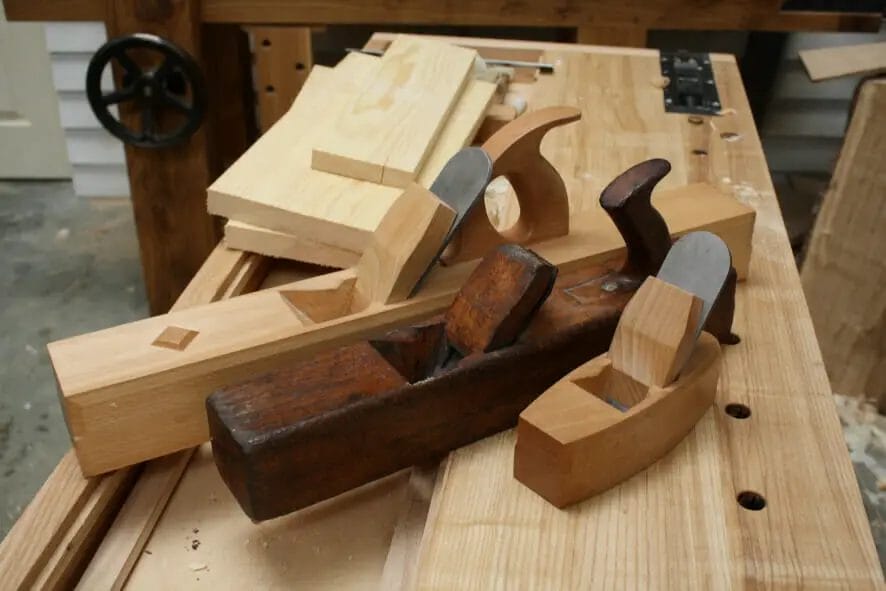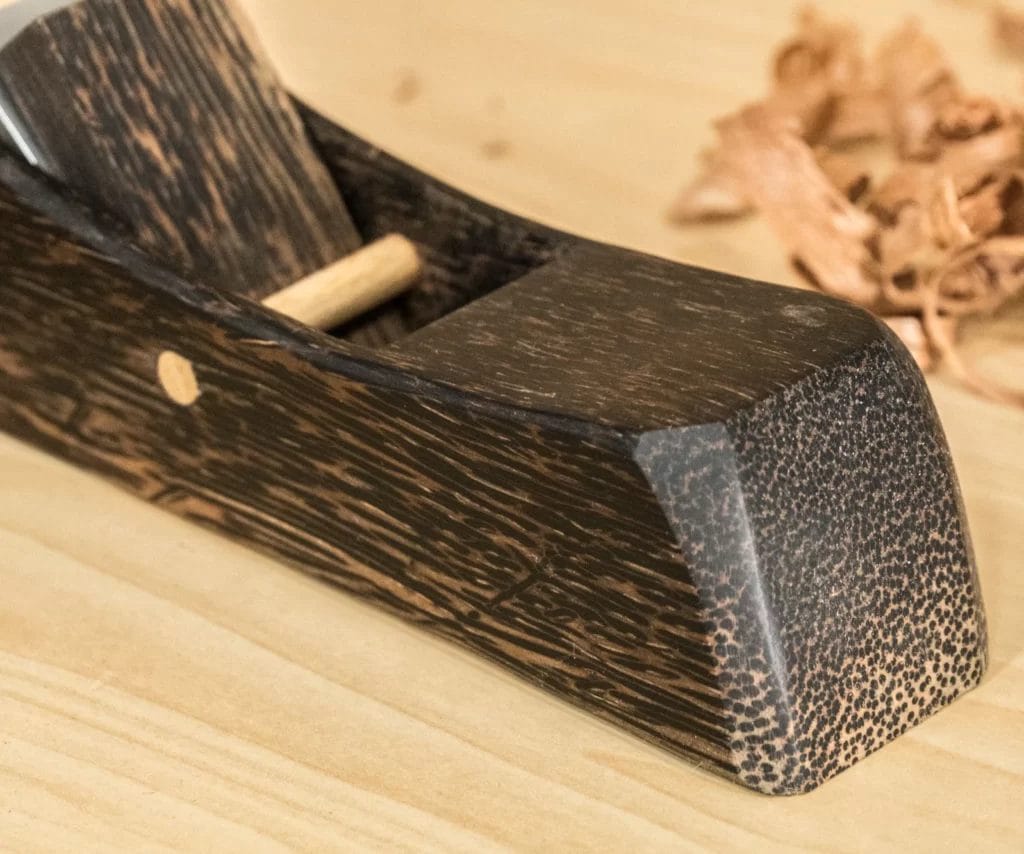Our Guide To Wood Planes & Their Types

Hand plane woodworking tools date back to a long time ago, these are said to go back to Egyptian times with modern wood planes not changing much in design.
Wooden planes have been designed to cut and smooth rough surfaces of wood manually without electricity and are excellent for precision, they do vary in their types of design however with some woodworking planes being more suited to different types of wood.
In our informative guide below we will take you through what wood planes are used for and how they work, the types of wood planes out there as well as what to look for in your wood plane for woodwork.
Let’s get into it!
What Are Wood Planes Used For?

Before we can get into talking about what type of wood planes there are, let’s discuss what these old school wood planes are used for in woodworking to see if the addition of one is right for your workshop.
- Smoothing of boards – A smoothing plane is used to smooth the rough surfaces of boards and is a great choice in place of a heavy sander which can cause damages to material.
- Flattening surfaces of boards – Flattening wood is often done before the smoothing plane above by a large jointer plane, this is often used when your workpiece is very long and avoids damaging the wood by using force.
- Joinery – Joinery is least common when working with wood and joinery planes are not often used. If your woodworking project does contain joints then you can find a variety of wood planes such as rabbet planes, for example, it is always good to use a corresponding joint plane to the wood joint you are working on.
How Do Wood Planes Work?
Wood planes are used to help level a rough surface of wood, they can also help to reduce the height of wood, the blade on most wood planes are adjustable to chop wood with it properly.
The amount of push your wood plane needs depends on the material you are cutting.
What Are The Different Types Of Wood Planes?

Wood planes come in numerous different types according to the finish on the wood you need and the angle of the primary cutting edge.
Down below we have listed all the different types of wood planes you can find for all your woodworking needs.
Jack Planes
The Jack plane is always the first in a collection of planes, it is used for smoothing boards and flattening boards for a smooth finish, measuring around 350mm, the plane is quite heavy.
Overall, the jack plane is a general-purpose wood plane.
Block Planes
Block planes are one of the smallest types in the wood plane family, they are used for finishing cuts and trimming the end grain of the wood, examples of block planes often are called an iron plane, they have a shallow cutting angle.
These planes measure around 150mm and the blade is positioned at a low level with the cutting bevel inside facing up.
Bevel Up Planes
Most bench planes have their cutting bevel facing down, bevel-up planes have their bevel sitting on the top side of the plane rather than the underside.
Smoothing Planes
A smoothing plane is a little longer than a block plane measuring 170mm in size and is used for flattening, finishing and smoothing wood boards thanks to the smaller size.
When a smoothing plane is at its sharpest it can be used to replace a sander.
Rabbet Planes
Rabbet planes are used to create rabbets in planks of wood, hence their name. This plane is fitted with a fence to keep cuts accurate as well as a depth stop to stop your cuts from becoming too deep.
The blade of a rabbet plane covers the whole width of the plane body allowing you to cut the flat side of a workpiece.
Japanese Hand Plane
Japanese planes differ from all kinds of others planes in the fact that they have wooden bodies. They are well known for their high accuracy due to the movement of the plane being pushed towards the user rather than being pushed away.
This type of plane additionally has its blade located at a sharp angle with the wooden body being less likely to damage the wood rather than an iron body type of plane.
Shoulder Planes
Shoulder bodied planes are known for extended plane blades over the edge of the device which allows for a broader cutting edge.
A shoulder type of plane can be used to cut rabbets as well as be used as a rebate plane for rebate cuts. The flat side of shoulder planes allows you to trim a piece of wood at the corners with ease.
Bullnose Plane
Bull nose planes are a shorter version of shoulder planes, you might find that this plane collection can sometimes have a removable front so as they can be converted to a chisel plane allowing you to get into the corners of your woodwork.
The plane blade of this model is wider than the body of the plane itself allowing you to get a straight and square-cut since it doesn’t go against the wall of the rabbet. Most of the time you would use a bullnose plane for adding finishing touches on work.
Jointer Planes
Jointer planes are around 20-24-inches in length and are a general-purpose plane that is typically used for smoothing woodwork and creating a smoother and flattened surface on lumber. This plane aims to allow people to trim and make a finer joint edge in their work.
Router Plane
Router planes are used to carve out shallow mortises, dadoes or grooves and often have a fence for accuracy when cutting. When looking at this type of plane they can often seem like a hand plane at first glance.
The router plane designs allow you to cut in two types of ways, the board position way and the second way being with the blade exposed which is perfect for cutting into corners.
Fore Plane
Fore plane designs are used for flattening boards of wood and measure around 460mm, due to the length of it, it prevents the plane from following peaks on wood shaving them instead, we would suggest using a fore plane to square stock.
Plow Planes
A plow plane can cut grooves and dadoes in wood rather than just cleaning them like a router plane, you can typically find that plow planes have different blade sizes which can be switched out according to the type of DIY you are doing.
Most plow planes will come with an adjustable fence for accurate cuts.
What To Look For In Your Wood Plane
Now we’ve discussed what you can use wood planes for, how they work and some different types you can find in the woodworking world you might be interested in purchasing your wood plane or a different type to add to your plane collection.
To make searching for the right wood plane easier, we’ve listed the essentials to watch out for in your model below.
- Type of frog – On most woodplanes, you will either find that they have a bailey frog or a bedrock, a bailey frog is on top of the handblade and can be adjusted by removing the screws inside of the plane while a bedrock wood plane will have a recess each side of it to keep it square, this can be adjusted too by removing the screws. A well-designed frog on a handplane is essential as to how it performs in woodworking.
- The thickness of the blade – This shows the rigidness of the blade, you want to ensure your hand plane comes with a thick blade to handle all kinds of projects and give a smoother finish.
- The angle of the blade – The angle of your blade is even more important than the thickness, blades at a low angle are best for cutting at the end of wood grain as it slices, blades at a higher angle like on Chinese planes, these are best for cutting complex grains in the wood. You will often find that bench planes have an angle of 45-degrees for cutting hardwood and softwood.
- Type of body – Metal body hand planes are much better for heavy-duty work while wooden planes have the advantage of being light so they can be used for longer periods, they are also less likely to damage your work than metal body planes.
Frequently Asked Questions About Different Types Of Wood Planes
Why can wood planes be very expensive?
If you are interested in buying a wood plane but you’ve found that they are very expensive you might be wondering why since these planes seem so simple at the first glance. The reason why these devices are high in price is due to the precision it takes to make them and high-quality wood materials.
How do I keep a wood plane in good condition?
You should take more care when storing your wood plane in comparison to other woodworking tools, this is because the wood can swell when it is exposed to extreme temperatures, if your wood plane is made from metal then it could potentially rust as well.
Which type of wood plane should I buy?
The type of wood plane you buy comes down to the kind of wood you will be working with, for example, a jack plane is better for general smoothing jobs while a jointer plane is better for fine details and finishing touches.
Final Words
Overall, wood planes come in a huge variety of different types and can be used for flattening, smoothing or finishing touches on wood thanks to their protruding blade. We would suggest as beginners starting with a jack plane, smoothing plane or bench plane since these are more general-purpose thanks to the angle of their blade.
